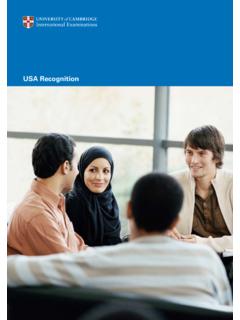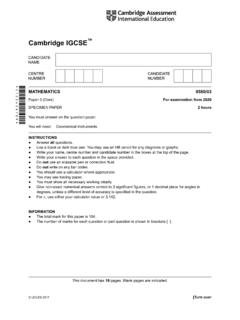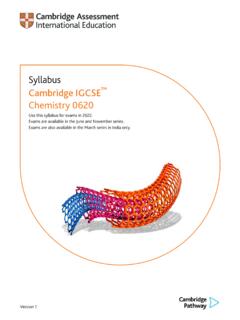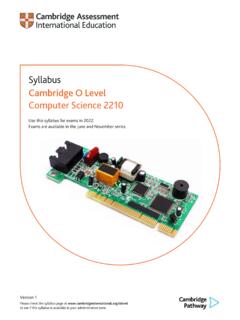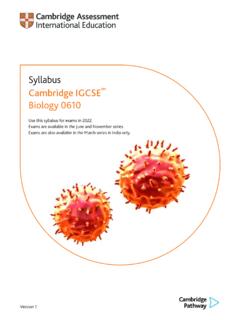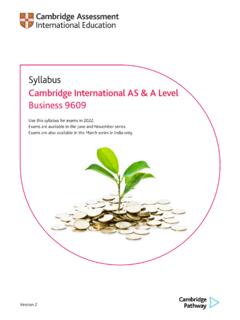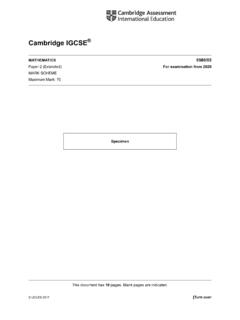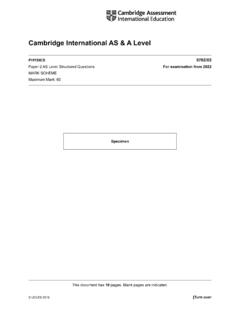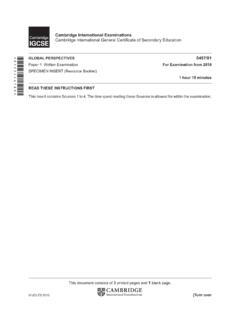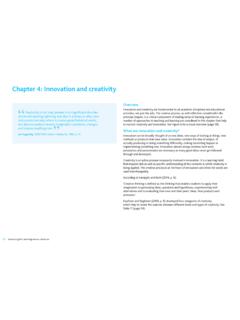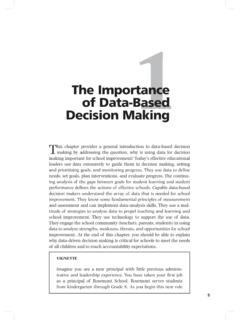Transcription of Assessment for learning
1 What does Assessment for learning mean?AfL focuses on both the teacher and student understanding three key things: 1. Where the learner is going. Sharing the aims of a lessonand success criteria helps learners to see what they areaiming for and what they need to do to achieve those Where the learner is now. Techniques such as effectivequestioning will help teachers to gauge what individuals andgroups have learnt during a lesson, generating evidence oflearning that both teacher and students can make use How can the learner get there? Teachers use thisevidence of learning to inform choices about what theywill do next with a class or individual students. Learners canuse this evidence to make decisions about their learning ,such as how to spend their independent study for learningAssessment for learning (AfL) is an approach, integrated into teaching and learning , which creates feedback for students and teachers in order to improve learning and guide their next is concerned with maximising the feedback process (teacher to student and student to teacher) to optimise student learning .
2 Feedback ranges from the informal ( oral comments given immediately to learners as they think through problems), to more formal ( written feedback given after an end-of-topic test). AfL also involves high-quality peer and self- Assessment where learners or peers may be involved in making decisions about future learning needs (Wiliam, 2018).The term Assessment for learning became popular in the 1990s. At this time there was concern that learners were being over-assessed and that there was a disproportionate focus on end results ( Assessment of learning ) rather than on Assessment processes that could actively enable learners to make progress. Both Assessment for learning and Assessment of learning are valuable in education, but they have different the learner is goingWhere the learner is nowSharing learning intentionsand success criteriaGaining evidenceof learningHow can thelearner get there?
3 Providing feedbackHelping learners to taketheir next stepsWhat is the theory behind Assessment for learning ? AfL is associated with social constructivist theories of learning . Mental models and assumptions that the learner uses to understand a subject are complex, and are constructed from previous experiences and interactions with others. This means the quality of interactions between teachers and learners is critical in the learning process. The work of Paul Black and Dylan Wiliam has been highly influential. Their pamphlet for teachers called Inside the Black Box (1998a) was based on a literature review of 250 sources on classroom Assessment practices (Black & Wiliam, 1998b). They found that the effective use of formative Assessment [see below] would increase achievement by between and standard deviations, which would be equivalent to a 50 to 70 percent increase in the rate of student learning (Wiliam, 2018, ).
4 Black and Wiliam (1998a) suggested that formative Assessment could be improved by: helping learners understand exactly what they have to do in order to succeed encouraging productive classroom discussion, including sufficient thinking time embedding opportunities for all learners to express their understanding providing feedback that helps students to move on in their learning and avoids comparison with other learners, then giving them the opportunity to act on that feedback training learners in self- Assessment and providing opportunities for them to be learning resources for each other terms are associated with Assessment for learning ? Formative Assessment has a similar meaning to AfL. The term was introduced to contrast with summative Assessment (see below), and show that Assessment could be used to form students learning and look forward to what they will learn next.
5 Some writers in this area see a distinction between AfL and formative Assessment ( Swaffield, 2011), while some use the two terms synonymously (see Wiliam, 2018, for further discussion). Summative Assessment means the same as Assessment of learning . Summative Assessment is used to sum up students learning at the end of a period for example, once a school term or a course has finished. As it sums up what the students have achieved, it looks back and indicates what the students have learnt, usually measured formally against clearly defined standards. Assessment for learning continued Diagnostic Assessment refers to Assessment that identifies what the learner knows or is capable of, perhaps at the start of a new topic. The focus is on identifying difficulties or misconceptions that the learner might have so that the teacher can plan learning activities to address summative and diagnostic Assessment activities could also be used to support Assessment for learning (see below).
6 What are the benefits of Assessment for learning ? AfL helps learners and teachers focus on the aim of their learning . This can help students understand what constitutes excellence , take responsibility for their own learning and plan how they might move forward. AfL encourages Assessment and learning to be seen as an integrated whole. The clarification of objectives and feedback about student learning will have a direct impact on the devising of teaching and learning strategies. According to research (Hattie, 2012), feedback has a positive effect on learner achievement (ranked 10th out of 150 factors), particularly if it involves feedback from learner to teacher. This is important as teachers need this information from learners in order to effectively modify their teaching. Many other factors identified as powerful influences in Hattie s analysis are also closely associated with are the challenges of Assessment for learning ?
7 Confusing function with instrument: Sometimes an instrument (such as a test) is seen as formative or summative, when these terms are intended to describe the purpose of their use (Wiliam, 2018). For example, a mid-term test might have both a summative and a formative purpose. It sums up learners attainment to that point, but it can also be reviewed and the information about learning used for a formative purpose, perhaps through an exam wrapper (see Education Brief: Metacognition), or to inform teachers planning for the next series of lessons. Fidelity of implementation: Wiliam (2018, ), said that the effective use of formative Assessment would increase achievement (emphasis added ). If AfL becomes a superficial exercise (for example a teacher formative comment copied by a student into a grid at the end of the unit, without any opportunity for the student to implement the feedback and with no change to future teaching), then it cannot be expected to make a positive impact on achievement.
8 Assessing long-term recall: Recent work from cognitive science encourages teachers to think about long-term recall of knowledge. This cannot be evaluated accurately when material has just been taught. Teachers need to plan opportunities for tests (which could be low stakes), which are spaced out over a period of weeks or months to encourage long-term recall (EEF, 2014). Change of practice: It can be challenging to implement AfL practices in a context where learners, teachers and parents are only familiar with summative Assessment . It is important to explain the rationale for changes, for teachers to understand them thoroughly and to implement them slowly over time (Black & Wiliam, 1998a). In particular, careful scaffolding and preparation is needed for learner self- and peer- Assessment . Workload: In some contexts, the implementation of written marking practices has had a negative impact on teacher workload (EEF, 2016).
9 It is important that AfL is embedded in everyday classroom practice (for example oral feedback at the point of need) and that written feedback is high-quality and strategically placed when it will have most tips: How can schools make the best use of Assessment for learning ? Professional development in AfL should be given a high priority. It needs to be ongoing and linked to each teacher s own professional practice. Schools can encourage teachers to work together to review and develop the school s Assessment policy and practice so that Assessment is seen as a positive method of encouraging students to learn and understand, without becoming an unreasonable burden on teacher workload. Make sure that written and oral feedback across the school is accurate, easy to understand and focused on learning , also that learners have the opportunity to put it into practice (Wiliam, 2018).
10 Teachers need support putting principles into practice. Teacher learning communities can change habits and improve teaching (see Getting Started with Peer Observation). Evaluate the impact of new strategies that are implemented, whether these are tried across the whole school or by individual teachers or departments (see Getting Started with Evaluating Impact). Allow a reasonable length of time for new strategies to impact on learner outcomes (Wiliam, 2016). Assessment for learning continuedHow can teachers make the best use of Assessment for learning ? Much of AfL is skilled practice that is core to being a good teacher. It involves multiple strategies : Sharing learning intentions and success criteria in an accessible and engaging way (Hattie & Clarke, 2019) and checking if learners have understood them. Using questioning to check and to deepen understanding within and across lessons.
